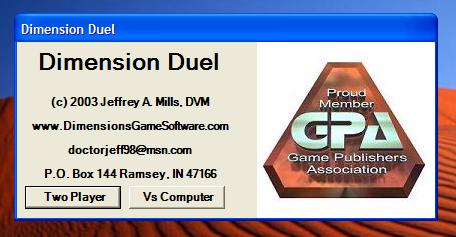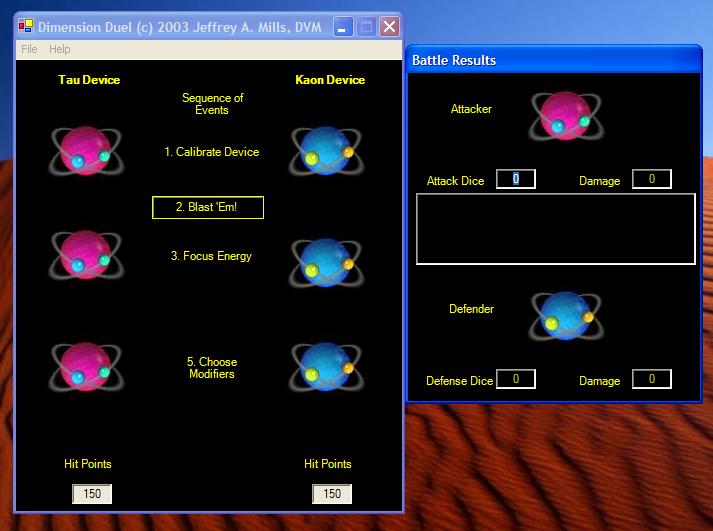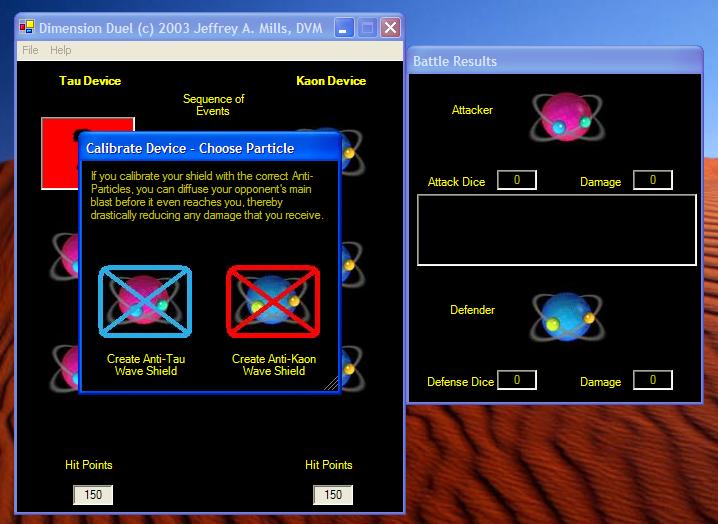|
Dimension Duel - The Story
This game actually has a rather lengthy story behind it. The unseen adversaries in this game are derived from a role-playing
game that, depending on when you're playing this, might still be in the development phase.
The history of the helix device that the characters, and thus the players, are using dates back hundreds of years...to
the late 1400's and early 1500's to be precise. The schematics for the device were taken from the sketchbooks of an artist,
inventor, and overall visionary named Leonardo da Vinci. In a time when many people were still in denial about the Earth's
true geometry, da Vinci was busily writing about long distance communications, parachutes, and submarines.
Of all his interests, however, one became somewhat of an obsession...an obsession that would be unfulfilled by him. He
realized that the air had density and compared wind to a flowing river. He believed that the secret to flight was in mimicking
the motion of birds and bats...in being able to move the 'substance' of the air with enough force to propel a man-carrying
machine.
One of his many designs was based on the same principles behind the modern helicopter. He designed a very large screw
like device that, according to da Vinci, when moved with sufficient force would be able to lift a person into the air. Leonardo's
design was powered by four men pushing on long spokes protruding from the shaft of the screw. In a modern helicopter,
these spokes, aka blades, may spin at speeds in excess of 400 mph. Unfortunately for da Vinci, four men are not capable of
running around in circles at such speeds.
Leonardo called his invention a 'helix' because of its spiral shape. Although his helix did not see fruition during his
lifetime, it was this very design that directly lead to the creation of two very awesome devices capable of warping the very
fabric of human existence, the two devices that are used in this game...and thus, in the role-playing game on which it is
based.
In the late twentieth century two inventors were born in rural Midwest towns. They met during college and became fast friends.
One was studying nuclear physics; one was studying electrical engineering. They both shared a passion for Medieval role-playing
games. While researching famous dead people in attempt to add some fresh characters to a stale game session, they came across
a book detailing the inventions of Leonardo da Vinci. When their eyes fell upon the schematics for da Vinci's helix, they
knew, without a doubt, that between the two of them and with the aid of modern, experimental nuclear power devices, that they
would be able to succeed where he failed.
Their very first test was a complete success. In just a few months, during the time they were supposed to be studying,
they scaled down the original, mammoth device powered by four men, into a go-cart sized personal helicopter. Without
even finishing their studies, they were hired by NASA to adapt their version of the helix device for use by astronauts during
space-walks. In just a few months, during the time they were supposed to be developing a device for space-walks, they had
created two small handheld versions that they thought would be the ultimate mode of personal transportation. These tiny handheld
devices were designed to move the substance of the air with enough force to lift a person into the air.
Their very first test was a complete disaster. These two small, nuclear powered devices succeeded in spinning the helix
at unimaginable speeds. The problem was that the force did not just move the air molecules themselves, but was so powerful
that it created a ray of energy so intense that it shifted the subatomic particles of all matter that it touched. Much of
NASA's research center was obliterated.
The two young inventors from rural Midwest towns agreed to destroy their research, part ways, and return to their homes
to work in less glamorous jobs...perhaps in sanitation. Both inventors broke their agreement. Both continued their research.
And both created devices capable of a more controlled release of energy. One created what he called the Tau Helix Device,
and one created what he called the Kaon Helix Device. The unfortunate creator of the Kaon device, however, inadvertently shifted
his own DNA. He became, for lack of better words, a crazed, lunatic, a not-quite-human bent on 'exploring' aka destroying
the entire universe...one small, rural town at a time.
This is where our card game begins. The creator of the Tau device has tracked down his long-time friend and now they must
battle...to the death.


Notes About The Original Game Design
This game is actually a two-player card game. Each of the individual selections that you make as you play were originally
designed to be placed on cards. The computer, however, provides a very functional interface...and avoids the cost of printing!
As you will discover during the course of game play, this game provides a great mix of random luck (the roll of dice to
determine damage) and the power of near complete control (choosing which card to play...they're all available from the beginning
of the game. If you lose, you can't say you were dealt a bad hand!). The seasoning on top is the unpredictability of a human
(or computer) opponent. You always have to worry that when you decide to fire your Intensifier (to double all damages) your
opponent might decide to fire his Deflector (to reverse all damages right back to you).
The beauty of the card-game version (which you can easily recreate by cutting up 3x5 index cards) is that new features
and multiple copies of existing features can be thrown into the mix. The dice used to calculate the final damages can also
be varied.
If you have suggestions that you would like to share with other players, please send them to doctorjeff98@msn.com and I'll
post them to this website!

Notes About Particle Physics
Particle. A subatomic object possessing a mass and a charge.
Antiparticle. For every particle there is another particle with the same mass but the opposite charge.
This is called the antiparticle.
Hadron. A particle made of quarks and/or gluons.
Quark. A fundamental fermion that has strong interactions.
Fermion. A particle with an odd-half-integer angular momentum (spin). No two fermions can exist in the
same state at the same time. Electrons, protons, neutrons, and quarks are all examples of fermions.
Gluon. The carrier particle of strong interactions.
Kaon. A meson with either a strange quark and an anti-up/anti-down quark, or an anti-strange quark and
an up/down quark.
Tau. The third largest lepton, with a charge -1.
Lepton. A fermion that does not participate in strong interactions.
Meson. A hadron made from an even number of quark constituents.
Confused. How one feels after reading a short glossary of elementary particle physics.



|